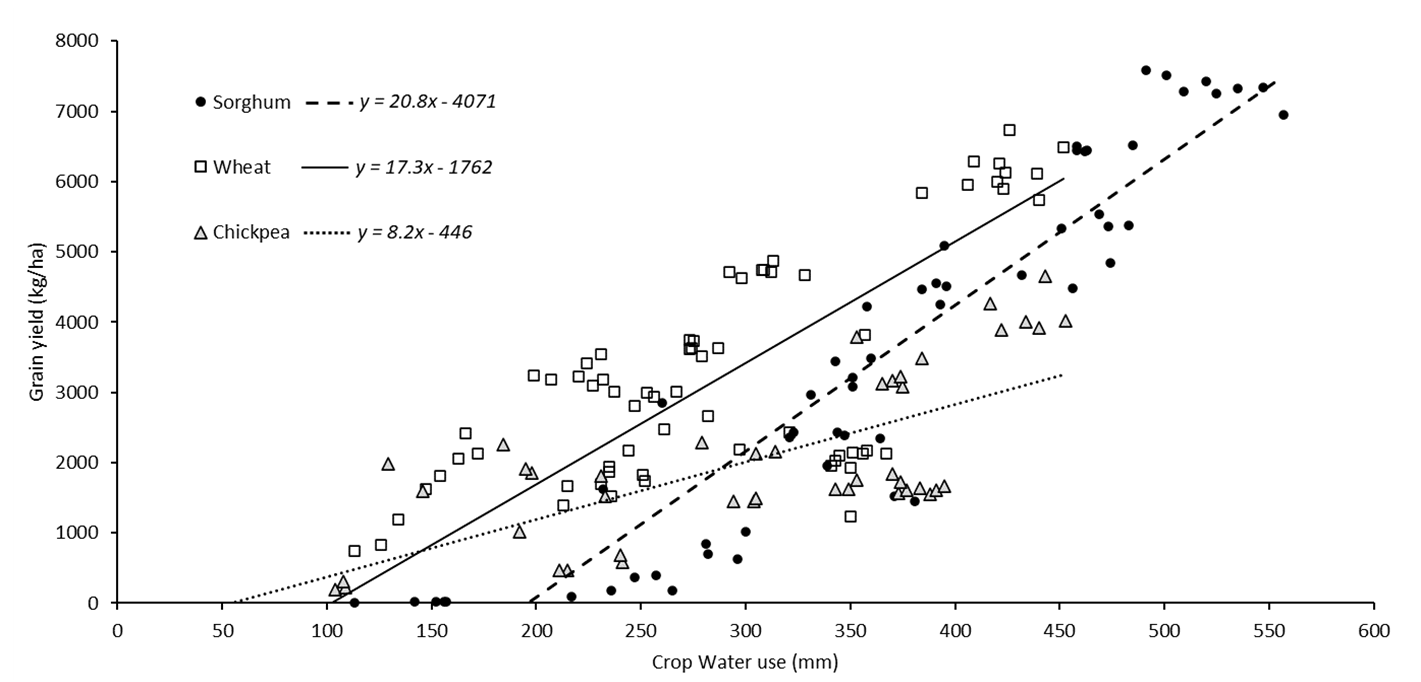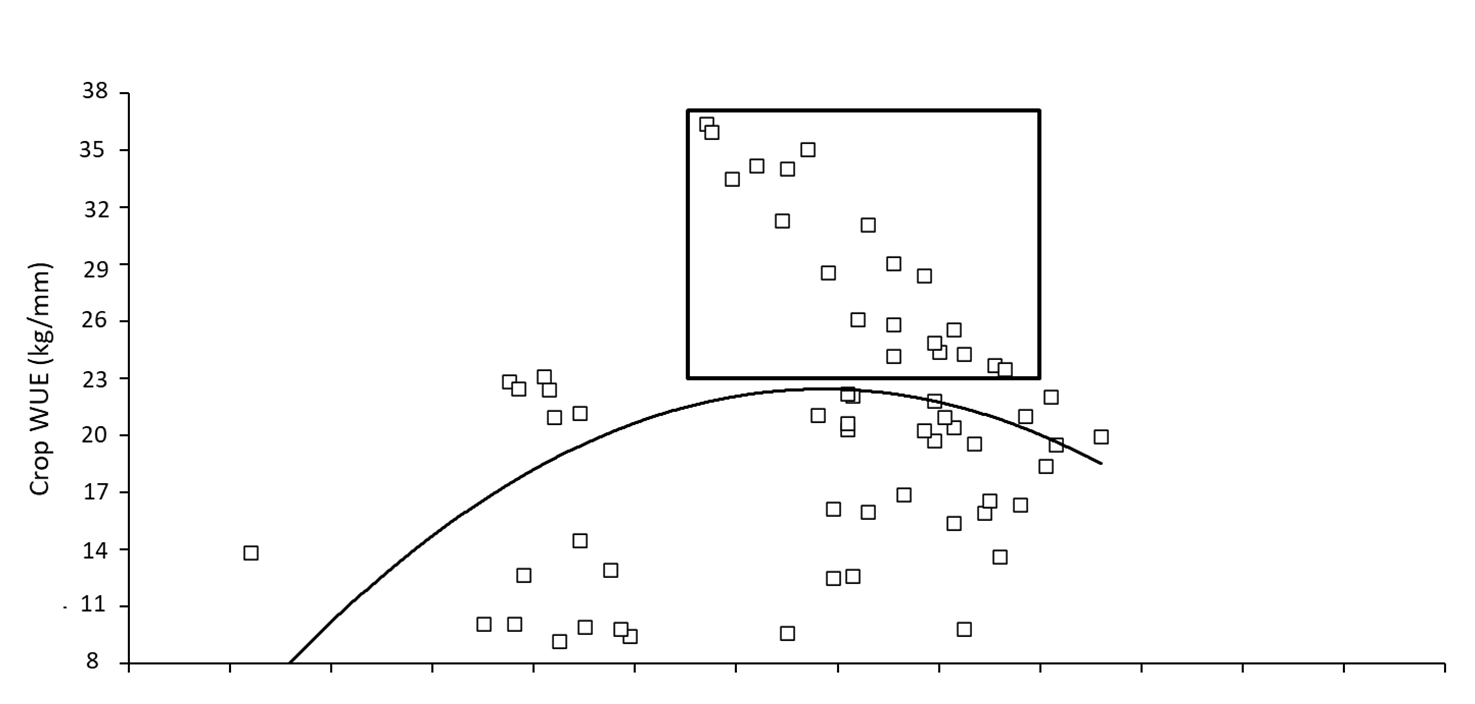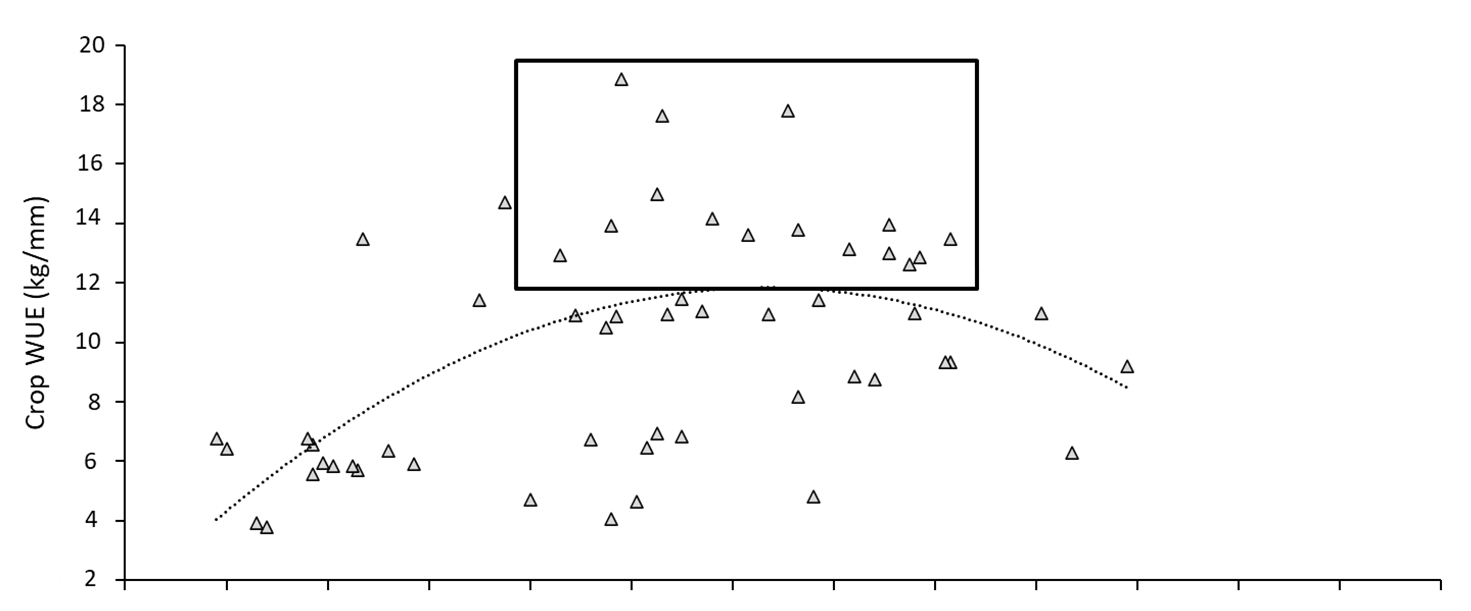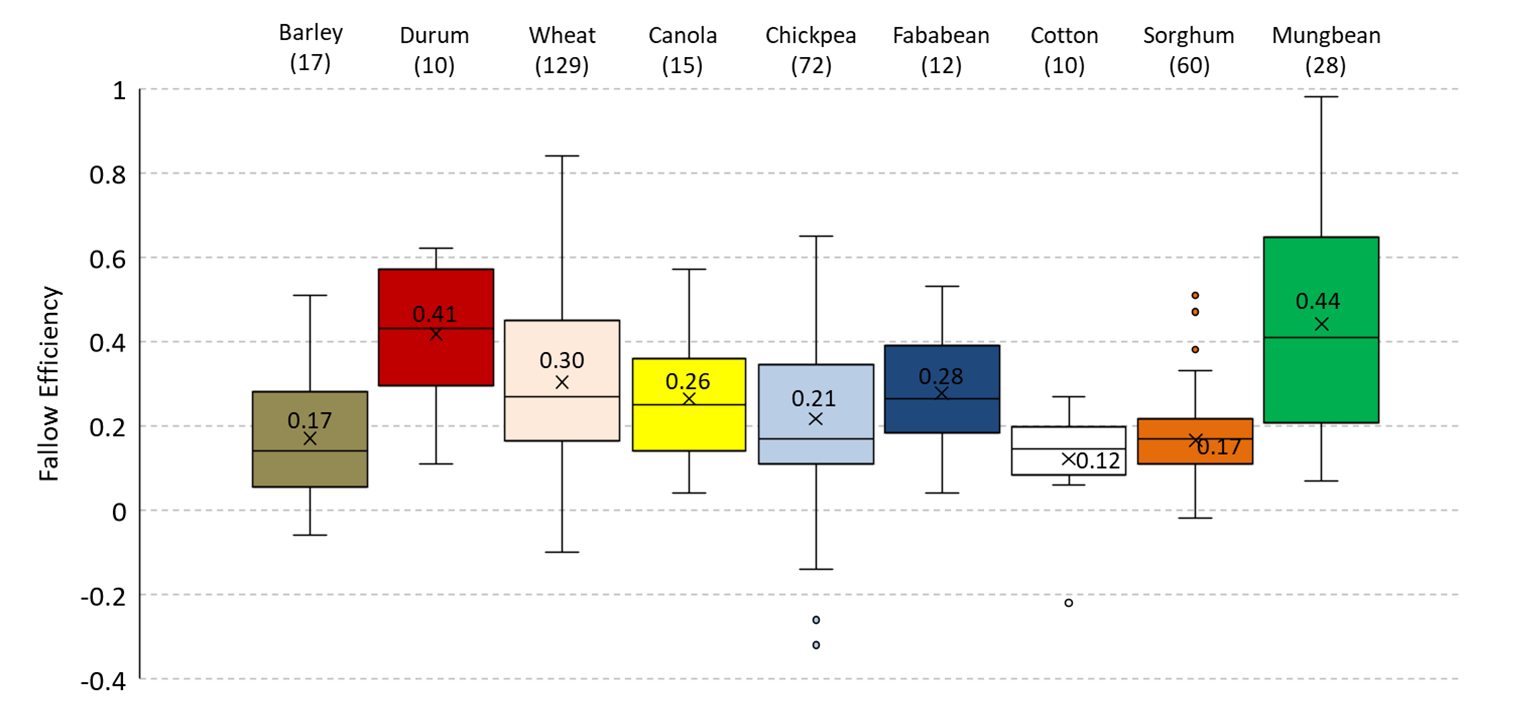Capturing and using water most efficiently: how much do crop system choices matter?
Author: Lindsay Bell (CSIRO), Andrew Erbacher (DAF Qld), David Lawrence (DAF Qld), Andrew Verrell (NSW DPI), Jon Baird (NSW DPI), Darren Aisthorpe (DAF Qld), Andrew Zull (DAF Qld), Jayne Gentry (DAF Qld), Greg Brooke (NSW DPI), Kaara Klepper (GRDC) | Date: 29 Nov 2023
Take home messages
- Fallowing to reach critical thresholds of plant available soil water (wheat >110 mm, chickpea >80 mm and sorghum >140 mm) is required to maximise crop water use efficiency
- Fallows are relatively inefficient, capturing on average 22% ± 4% of rainfall
- Large variation in fallow efficiency (FE) exists due to climatic conditions, residual soil water, crop residues and fallow length – hence, tools to predict this can be useful
- Lower fallow efficiencies can be expected under longer fallows, where more water remains at harvest, and following crops leaving residues with less quantity and persistence (i.e., legumes or cotton)
- Higher fallow efficiencies occur: over shorter fallows, with drier soil profiles, and following crops with high levels of ground cover (e.g., winter cereals)
- Higher intensity cropping systems with more time in crop use more of the rainfall but achieve lower crop water use efficiency (WUE), while lower intensity systems use less rainfall but turn this into grain more effectively, and
- Balancing time in fallow and crop WUE by applying thresholds is critical to maximise system water use efficiency and overall returns per mm.
Introduction
The efficiency that soil water accumulates during fallows and availability of that soil water for use by crops are key drivers of farming system productivity and profitability. Using fallows to accumulate soil water to buffer subsequent crops against the highly variable climate is critical in northern grain production systems. A range of factors can influence the efficiency of fallows (i.e., the proportion of rain that accumulates in the soil profile) including ground cover, seasonality or timing of rainfall events, the length of the fallow, and residual water left at the end of the preceding crop. Further, while accumulating more soil water prior to sowing a crop is always preferable, this often requires longer fallow periods, resulting in additional costs for maintaining that fallow and the number of crops grown declines. However, crops with higher starting water are often more efficient and less reliant on in-crop rainfall to drive their final yield. Hence, optimising water use efficiency of the farming system is a balancing act between maximising fallow water accumulation and the capacity of crops to convert available water into product (crop water use efficiency (WUE)). Here we look at how different farming systems have impacted on these factors. We use data collected from farming systems experiments over the past seven years to explore these questions.
Crop water use efficiency and influence of soil water
Crop water use efficiency is the amount of grain produced per mm of water available to the crop, including rainfall during the growing season plus soil water at sowing, minus the residual water left at harvest. Figure 1 shows this relationship for wheat, chickpea and sorghum across our farming systems experimental data; the average WUE (kg grain per mm) for wheat was 17.3, for chickpea was 8.2 and for sorghum was 20.8. However, there is always significant variability in this WUE due to differences in growing season conditions, timing of rainfall and/or other factors that might reduce crop performance (e.g., nutrient deficiencies, disease). The best 20% of crops in this dataset achieved a WUE of 23.2 for wheat, 11.8 for chickpea and 25.1 for sorghum.
Figure 1. Relationship between crop water use (i.e., soil water extraction plus rainfall) and grain yield (i.e., crop WUE) across crops monitored in northern farming systems experiments. The slope of the line indicates WUE of each crop and the X-intercept the estimate of the minimum water available to produce grain for each crop.
Figure 1 also clearly shows that there is a minimum amount of water required before a crop will produce yield. This is the amount of water required to grow sufficient biomass to produce grain. Based on our data this is about 60 mm for chickpea, 100 mm for wheat and 200 mm for sorghum. Sorghum is higher because it grows during summer with a higher evaporative demand.
Using this data, we looked at the relationship between crop WUE and available soil water at the start of the sowing window (Figure 2). Across all crops, those with lower soil water achieved lower crop WUE, that is they were less able to convert the available water into grain yield. This indicates that these crops were likely to have encountered water stress which meant they were not able to convert biomass into grain yield. Equally crop WUE often declines at higher water availability, when surplus rainfall does not become available to the plant due to runoff, or is lost via higher evaporation.
The boxes in Figure 2 indicate those crops that achieved the best WUE, which corresponds with the peak of the curve. For each crop there are critical soil moisture levels where crops are more likely to maximise their WUE: 110-180 mm plant available water (PAW) for wheat, 80-160 mm PAW for chickpea and >140 mm for sorghum. While the outcome for each crop is going to be a result of subsequent seasonal conditions, these values indicate a trigger to sow these crops that enables them to use their water most effectively to produce grain.
Figure 2. Relationship between crop WUE and plant available soil water (PAW, mm) sampled at the start of the sowing window for wheat (top, open squares), chickpea (middle, grey triangles) and sorghum (bottom, black circles) across farming systems experiments.
Fallow water accumulation – what can influence it?
Two main factors drive the amount of water that is available at sowing – the amount of water that accumulates over the prior fallow period and any residual moisture left from the previous crop. Fallow efficiency is the proportion of rainfall during a fallow that accumulates in the soil profile. Hence, achieving a higher fallow efficiency can significantly increase the available water for subsequent crops. For example, a fallow receiving 400 mm of rain with an efficiency of 25% will have accumulated 100 mm of soil water at sowing while a fallow with an efficiency of 20% would have only accumulated 80 mm. This difference could have a significant impact on the opportunity to sow a crop and/or the gross margin of the following crop.
Environmental conditions such as the timing of rainfall events greatly influences the efficiency of fallows, which can vary dramatically from season to season. Overall, most of our baseline systems representing current district best practice achieved fallow efficiencies of 22% ± 4% over the whole cropping sequence. This is consistent with long-term simulations which show fallow efficiencies of 21-24% for cropping systems with crop intensities of 0.75-1.0 crops per year (i.e., 66-75% time in fallow).
These values are lower than those calculated by others historically, such as Robinson & Freebairn (2017) that report fallow efficiencies of 25-30% under no-till. Past research mostly examined systems where winter cereals were a larger component of the farming system, compared with cropping systems used now which include a higher proportion of legumes and summer crops, which are likely to achieve lower fallow efficiencies (see further results below). Our data suggests that using a generic 30% fallow efficiency may over-estimate fallow water accumulation in most cases, at least where cropping systems are not dominated by winter cereal crops.
Over our experimental years, environments with more winter-dominant rainfall had lower fallow efficiencies over summer fallows – this is likely due to smaller and less frequent rainfall events occurring during summer fallows meaning that soil water accumulates less efficiently.
1. How much do different crop residues (legume vs cereal or other) and fallow lengths impact fallow water accumulation?
Across the farming systems sites we monitored fallow water accumulation following a range of different crops which includes residual soil water and final soil water for over 350 previous crops. Here we have collated this data in order to compare how different crop types impact subsequent fallow efficiencies (Figure 3). This data highlights the large variability in fallow efficiency that occurs and demonstrates some clear crop type effects on subsequent fallow efficiencies.
Figure 3. Summary of observed fallow efficiencies following different crop types across all farming systems sites between 2015 and 2022; only crops with 10 or more fallows are included. Boxes indicate 50% of all observations with the line the median and the x the average; the bars indicate the 10th and 90th percentile of all observations. Numbers in brackets indicate the number of fallows included for each crop type.
This data clearly shows the following effects of different crops:
- After winter cereal crops, fallow efficiencies are higher than after winter grain legumes and to a lesser degree, canola. The median fallow efficiency following all winter cereals was 0.27 (includes wheat, barley and durum), while following chickpea and other grain legumes was 0.19, with canola intermediate (0.23).
- After sorghum, fallow efficiencies are typically lower than after winter cereals (median of 0.17)this is due to a combination of more long fallows after sorghum. Short fallows after sorghum are generally higher efficiency than long fallows (i.e. 0.21 compared with 0.16).
- Fallows after cotton are the lowest efficiency (0.12) due to often being longer, with less residue and/or tillage for pupae control.
- Fallow efficiencies following mungbean were highly variable and while the data indicates high fallow efficiencies this is likely due to the residues remaining from previous cereal crops, as the mungbeans are often double cropped following wheat.
Fallow length also impacts on fallow efficiencies. Across our dataset longer fallows are generally less efficient – long fallows of >9 months have a median efficiency of 0.16, short fallows (4-9 months) have a median efficiency of 0.23, while fallows involving a double crop (i.e., <4 months) have a median efficiency of 0.33.
2. Residual water contribution to water availability for subsequent crops
Fallow efficiency is also affected by residual soil water at harvest, with drier soils resulting in typically more efficient fallows than situations with more residual moisture. Hence, lower fallow efficiencies don’t always translate into less soil water at sowing of the next crop.
For example, legume crops often (but not always) leave soil water at harvest and despite lower fallow efficiency following grain legumes they may have similar water available for the next crop. In Table 1 we have compiled cases where chickpeas and wheat have been grown in the same season. On numerous occasions we observed higher residual soil water at harvest after pulse crops (chickpeas, fababeans or field peas) compared to after wheat, on average this has been 41 mm more soil water post-harvest compared to wheat. This was often associated with rainfall later in the crops development where the winter cereals were able to extract this water while the pulses were maturing and did not utilise this additional water. However, at the end of the subsequent fallow this difference was greatly reduced so that on average only 10 mm more water remained in the soil profile after chickpea compared to wheat or barley. What this means, is that you shouldn’t bank on the additional moisture after a grain legume translating into additional soil water available for subsequent crops, but equally fallow efficiency is not the only contributor to soil water in the next crop.
Table 1. Residual soil water at harvest and subsequent fallow water accumulation after chickpea and wheat compared across 7 sites/years.
Site | Crop | Residual water at | Fallow | Fallow rain | Final soil water |
|---|---|---|---|---|---|
Emerald | Wheat | 44 | 0.20 | 525 | 150 |
Emerald | Wheat | 93 | 0.16 | 341 | 147 |
Emerald | Wheat | 56 | 0.33 | 364 | 177 |
Pampas | Wheat | 61 | 0.38 | 459 | 238 |
Pampas | Wheat | 41 | 0.47 | 299 | 182 |
Pampas | Wheat | 9 | 0.25 | 344 | 96 |
Pampas | Wheat | 28 | 0.18 | 228 | 69 |
3. How much does fallow efficiency vary amongst farming systems approaches?
We have analysed the efficiencies of all fallows within different farming systems by calculating the ratio of all rain falling during fallow periods to total accumulated soil water over these fallows across the whole crop sequence (not just individual crops). Significant differences in the efficiency of fallows are also found between different farming systems treatments tested across the sites. Key findings are:
- Higher crop intensity increased fallow efficiencies at most sites. This is due to less time in fallows and fallows having lower soil water content meaning less water is lost to evaporation.
- Conversely, systems with lower crop intensity had lower fallow efficiencies due to longer fallows and a greater proportion of rain and time in fallows meaning evaporative losses are higher.
- Systems with higher legume frequencies had lower fallow efficiencies (5% lower), particularly where they were reliant on summer rain accumulation. At several locations this effect was large, particularly where legumes were followed by a long-fallow period. This is due to the lower residue cover which breaks down faster following grain legume crops compared to cereals.
- On average, systems aimed at increasing crop diversity achieved similar fallow efficiencies to the baseline systems (regional baseline or reference system). However, there was large site-by-site variability, half the sites had a higher and half had a lower fallow efficiency. There were significant differences in how increasing crop diversity was achieved across the various locations (e.g., some involved alternative winter break crops, some involved long fallows to sorghum or cotton), which is likely to bring about these variable results.
Table 2. Comparison of fallow efficiency (i.e., change in soil water/fallow rainfall) for different cropping system strategies at 7 locations across the northern grains region. Colouring of numbers indicate the difference from the regional baseline or reference system – black = reduction, light grey = increase.
*Crop system does not yet vary from the baseline in this regard
Balancing fallow to achieve overall farming system water capture
The range of factors that affect fallow water accumulation and the balance of fallow and time in crop drive differences in water use over the whole farming system. Hence, it is important to find the right balance between the time in fallow required to accumulate sufficient water to maximise crop WUE, while at the same time not dramatically reducing overall system water capture.
Firstly, lets look at how much the overall system water capture and water use can vary between farming systems. Table 3 shows the proportion of total rain that was used by crops for the various farming systems at each location. Crop choice, like introducing more legumes or more diversity, have small positive or negative effects on total system water use, but big differences are driven by the cropping intensity (i.e., % of time in crop). Higher intensity systems almost always increased the proportion of total water use compared to the Baseline, and on the counter, Lower intensity systems reduced the total water use.
To illustrate this with an example, let’s consider an environment receiving an average of 600 mm of rainfall per year. A lower intensity farming system where a crop is receiving 70% of rain in the fallow period (e.g., 0.6-0.7 crops per year) with fallow efficiencies of 0.16, would accumulate 67 mm in fallow per year and in-crop rain would be 180 mm per year – resulting in total crop water use of 247 mm per year (41% of rainfall). In contrast, a farming system that captures 50% of the rain in fallows (1.2-1.4 crops per year) with fallow efficiencies of 0.30, would accumulate 90 mm of water per year and 300 mm per year would fall in-crop – resulting in a total crop water use of 390 mm (65% of rainfall). This means a crop grown after a longer fallow in a lower intensity system to be equally profitable must generate 1.6-times the grain/gross margin per mm of water used.
Table 3. Comparison of total water use as a percentage of total rainfall between different cropping system strategies at 7 locations across the northern grains region. Colouring of numbers indicate the difference from the regional baseline or reference system – black = reduction, light grey = increase.
*Crop system does not yet vary from the baseline in this regard
So the question is: how much more productive or profitable are crops that are sown on a higher water threshold?
From the farming systems data, we have eight examples of where a common crop was sown at the end of fallows of varying length and different starting water (Table 4). In every comparison, higher PAW at planting resulted in increased grain yield, which in seven of the eight comparisons improved WUE. However, it is important to also factor-in the fallow rain required to achieve the higher plant available water at sowing. Here we have calculated this as the rainfall use efficiency (RUE) of these crops, i.e., grain yield/(prior fallow rain + in-crop rain). This shows that once the efficiency of fallow water accumulation is considered then in most cases there was little difference in productivity of the systems in terms of kilograms grain produced per mm of rain. The only exceptions were a chickpea crop following an 18-month fallow at Pampas in 2017 and a sorghum double-crop at Pampas in 2017/18.
However, there were more clear differences in system gross margin per mm of rain. Crops sown outside the optimal range of soil water (either too high or too low), converted rainfall ineffectively into profit in comparison to crops grown in the same season with optimal soil water at sowing. For example, in wheat, all the crops sown with pre-plant PAW <100 mm achieved lower $/mm returns. For sorghum, the two crops sown with <140 mm PAW achieved lower $/mm returns. Across these comparisons the marginal gain in profit per mm of additional water at sowing ranged from $0.50 to $14.90, but was mainly between $1.10/mm and $2.20/mm.
Table 4. Comparison of yield and water use of crops with varying lengths of preceding fallow, for a range of crops and locations. Double crop is 0-4 months fallow; short fallow is 4-8 months; long fallow is 9-18 months.
Site | Fallow | Pre-plant PAW | Grain yield | Crop WUE | Rainfall Use Efficiency | Crop gross margin | $/mm |
|---|---|---|---|---|---|---|---|
Wheat | |||||||
Emerald | Double crop | 100 | 2.35 | 8.3 | 5.3 | 512 | 1.15 |
Billa Billa | Double crop | 65 | 1.13 | 5.6 | 4.2 | 211 | 0.78 |
Pampas | Double crop | 53 | 1.56 | 3.4 | 3.4 | 258 | 0.56 |
Sorghum | |||||||
Billa Billa | Short fallow | 131 | 0.62 | 2.3 | 1.7 | -138 | -0.37 |
Pampas | Short fallow | 147 | 4.51 | 10.8 | 8.2 | 1033 | 1.88 |
Pampas | Double crop | 96 | 0.65 | 2.2 | 2.2 | 30 | 0.10 |
Chickpea | |||||||
Pampas | Double crop | 45 | 1.30 | 3.6 | 3.6 | 455 | 1.26 |
Billa Billa | Double crop | 163 | 0.82 | 4.5 | 2.7 | 209 | 0.69 |
Conclusions
Overall, these farming systems experiments have shown that systems with less time in fallow increase system water use and WUE through higher fallow efficiency. However, significantly higher returns for crops sown on higher plant available water more than compensates for the low efficiencies of fallow water accumulation. Crops sown on sub-optimal PAW at sowing did not achieve a higher conversion of water into profit and hence applying appropriate thresholds to sow your crops enables the system water use efficiency to be optimised. Though, this does mean that it is critical to optimise management and inputs for crops following long-fallows in order to convert the extra water efficiently into yield outcomes.
Further reading
Water use and accumulation
Lindsay Bell, Andrew Erbacher (2018) Water extraction, water-use and subsequent fallow water accumulation in summer crops.
David Freebairn (2016) Improving fallow efficiency.
Kirsten Verberg, Jeremy Whish (2016) Drivers of fallow efficiency: effect of soil properties and rainfall patterns on evaporation and the effectiveness of stubble cover.
Local farming systems experiments
Andrew Erbacher, David Lawrence (2018) Can systems performance be improved by modifying farming systems? Farming systems research – Billa Billa, Queensland.
Darren Aisthorpe (2018) Farming systems: GM and $ return/mm water for farming systems in CQ.
Jon Baird, Gerard Lonergan (2018) Farming systems site report – Narrabri, north west NSW.
Andrew Verrell, Lindsay Bell, David Lawrence (2018) Farming systems – Spring Ridge, northern NSW.
Lindsay Bell, Kaara Klepper, Jack Mairs, John Lawrence, Andrew Zull (2018) Farming system impact on nitrogen and water use efficiency, soil-borne disease and profit.
Lindsay Bell, Kaara Klepper, Jack Mairs, John Lawrence (2017) Improving productivity and sustainability of northern farming systems: what have we learnt so far from the Pampas systems experiment?
Lindsay Bell, David Lawrence, Kaara Klepper, Jayne Gentry, Andrew Verrell, and Guy McMullen (2015) Improving northern farming systems performance.
Acknowledgements
The research undertaken as part of this project (CSA00050, DAQ00192) is made possible by the significant contributions of growers through both trial cooperation and the support of the GRDC, the authors would like to thank them for their continued support. We would also specifically like to thank all the farm and field staff contributing to the implementation and management of these experiments, the trial co-operators and host farmers.
References
Robinson JB, Freebairn DM (2017) Estimating changes in Plant Available Soil Water in broadacre cropping in Australia. In ‘Proceedings of the 2017 Agronomy Australia Conference’, 24 – 28 September 2016, Ballarat, Australia.
Contact details
Lindsay Bell
CSIRO
PO Box 102, Toowoomba Qld, 4350
Mb: 0409 881 988
Email: [email protected]
Date published
November 2023
GRDC Project Code: DAQ1406-003RTX, CSP1406-007RTX,
Was this page helpful?
YOUR FEEDBACK







